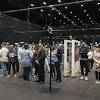Ucl
2024 - 9 - 17UCL Turns Walls Into Art: The Gallery Experiment You Won't Believe!
art gallery - clinical creators - design - digital outreach - mental health - PEARL - public spaces - UCL - YouTube HealthDiscover how UCL's groundbreaking experiment is reshaping space design while testing your walking skills—perfect for art lovers and engineers alike!
At UCL's cutting-edge PEARL (Person Environment Activity Research Laboratory) facility in East London, a groundbreaking experiment has been transformed into an art gallery. Over 100 volunteers took part in a unique study designed to explore how the layout of movable walls affects human behaviour. The cleverly constructed space mimicked the ambiance of a traditional art gallery, inviting participants to explore a nuanced environment and providing valuable data about how we interact with physical spaces. It's like a creative version of a maze, without the cheese!
Participants were guided through the 15m² area, where they navigated between walls that could be rearranged and adjusted for optimal art-viewing experience. With sensors tracking their movements, researchers collected data on how the arrangement of walls influenced everything from foot traffic to attention span. This intriguing study aims to enhance architectural design in various environments, from museums to offices—a pivotal step towards making spaces more engaging and user-friendly. Who knew that walking around could be such valuable information gathering?
The charming experiment strikes a chord not only with art enthusiasts but with design aficionados and psychologists alike. The findings could lead to more thoughtfully arranged spaces that cater to our innate human behaviours. Imagine strolling through your favourite gallery while also benefitting from the latest research in spatial design—now there's a reason to be excited about your next museum visit!
As UCL paves the way for innovative designs, this experiment has broader implications for public spaces everywhere. The data gleaned from these sessions could significantly shape how spaces are designed in the future, leading to better experience and functionality. As some might say, the walls truly do have ears— and they’re all about creating engaging spaces!
Fun Fact: Did you know that the concept of movable walls has been popularised in modern architecture for decades? It allows for versatile spaces that can adapt to various activities. And speaking of adaptation, the art of designing these spaces is as much about psychology as it is about aesthetics!
Another interesting tidbit: While this experiment was all about art galleries, similar principles are applied in places like offices and hospitals. Creating an environment that promotes ease of movement and emotional well-being can fundamentally change how we live, work, and play!

UCL 'art gallery' experiment aims to inform better design of spaces (The Engineer)
Over 100 volunteers were tracked walking through a custom-built network of moveable 'walls' at UCL's PEARL (Person Environment Activity Research Laboratory) facility in East London. Measuring 15m2, the space was set up to resemble an art gallery, ...

UCL partners with YouTube Health to improve access to mental ... (Health Tech Newspaper)
The collaboration aims to train more than 100 clinical academic staff in creating their own content with the view to develop a “clinical creators network” at ...
Explore the last week
- 2024 - 12 - 20, 25 topics across 214 articles.
- 2024 - 12 - 19, 23 topics across 278 articles.
- 2024 - 12 - 18, 39 topics across 444 articles.
- 2024 - 12 - 17, 30 topics across 399 articles.
- 2024 - 12 - 16, 20 topics across 210 articles.
- 2024 - 12 - 15, 50 topics across 641 articles.
- 2024 - 12 - 14, 38 topics across 411 articles.